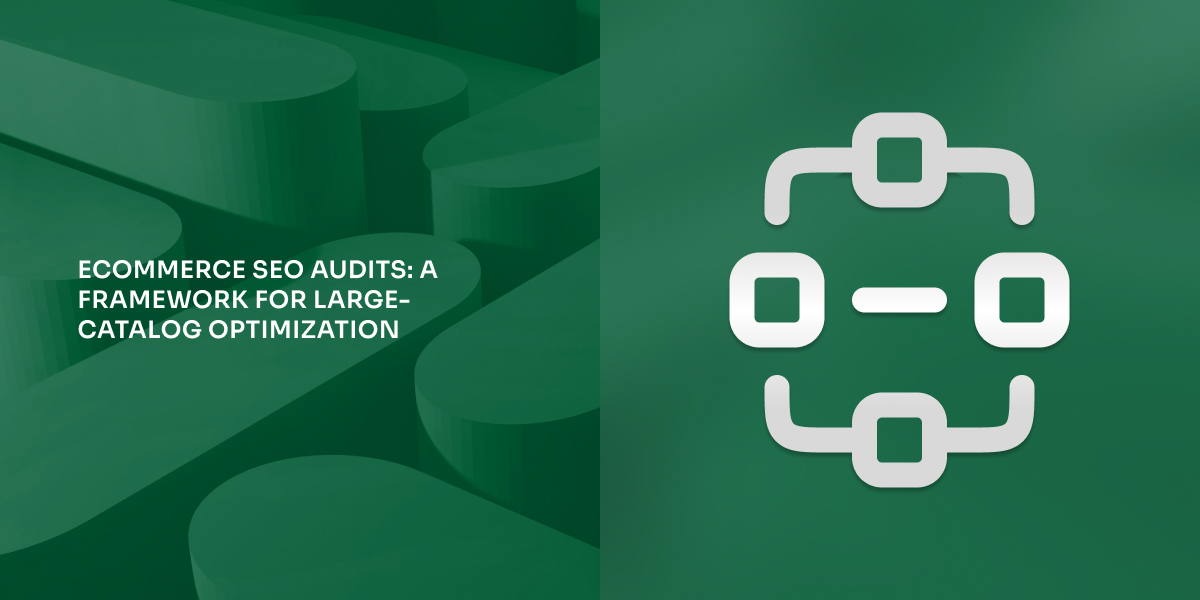Ecommerce SEO audits: a framework for large-catalog optimization

A writer-marketing assistant with a background in sociology and research, Alyanna is part of the marketing team at 1902 Software. As one of the newer members, she brings a fresh perspective and a growing curiosity about how technology helps businesses—especially in the B2B sector—connect with their audiences more effectively. She contributes to the team’s efforts in creating marketing materials and supporting initiatives for both 1902 Software and WriteText.ai.

For online retailers managing thousands—or even millions—of product pages, keeping search visibility strong isn’t just about great content. It’s about spotting the technical barriers, indexation inefficiencies, and content gaps that quietly limit performance. This is why an ecommerce audit strategy tailored for scale is essential when standard SEO practices fall short.
Large catalogs pose unique challenges. Faceted navigation often causes duplicate content, templates can produce thin pages, and internal linking structures weaken as your inventory grows. Without a structured approach to auditing your ecommerce site operations, even well-meaning optimization efforts can miss hidden issues.
This article provides a practical framework for conducting ecommerce SEO audits on large product catalogs, complete with actionable checklists and proven methodologies that address crawl efficiency, indexation control, and content quality at scale.
Understanding the scope of large-catalog SEO challenges
Before diving into the audit process, it’s important to understand what makes large ecommerce sites behave differently. According to Ahrefs, sites with 10,000+ pages face exponentially higher risks of crawl budget waste, with search engines often discovering but not indexing significant portions of product inventories.
The biggest challenges include:
- Crawl efficiency degradation as site architecture becomes more complex.
- Indexation dilution when low-value pages compete with high-value products.
- Template-driven content that results in thousands of nearly identical pages.
A proper audit ecommerce framework addresses each of these systematically rather than applying surface-level fixes.
Phase 1: Crawl health assessment
Your first priority is understanding how search engines navigate your catalog. Crawl health determines whether your best products ever get discovered, making it the foundation of all SEO for product pages.
Critical crawl metrics to monitor
Start by analyzing your server logs and Search Console data to spot:
- Crawl frequency patterns across different site sections
- Orphaned pages that receive no internal links
- Redirect chains that waste crawl budget
- Server response times exceeding 200ms for product pages
Tools like Screaming Frog or Sitebulb can map your entire site architecture, revealing how many clicks separate your homepage from deep catalog pages. Aim to keep critical product pages no more than three clicks deep.
Crawl budget optimization checklist
- Identify and noindex low-value pages (empty categories, outdated filters)
- Eliminate redirect chains longer than two hops
- Audit robots.txt to ensure critical pages aren't blocked
- Review server logs for excessive bot traffic on non-essential pages
- Implement strategic XML sitemaps segmented by product priority
- Monitor 404 rates and fix broken internal links monthly
Google's crawl budget documentation sites also indicate that you should prioritize making their most valuable content easily discoverable rather than ensuring every page gets crawled.
Phase 2: Indexation rules and management
Once your pages are crawlable, the next step is ensuring they’re indexed correctly. Mismanaged indexation can dilute visibility and reduce your product pages' SEO performance.
Faceted navigation control
Filter systems (by color, size, price, etc.) can generate millions of URL combinations from just a few thousand products. To prevent index bloat:
- Canonicalize correctly. Point filter URLs to the main category or the preferred canonical version. Moz's technical SEO guide recommends this for keeping rankings consolidated.
- Noindex strategically. Exclude filter combinations that add little unique value (example: "red products under $20 sorted by newest").
- Parameter handling. Use Google’s URLParameters tool to indicate which parameters change page content meaningfully.
Indexation audit checklist
- Map all URL parameter patterns generated by site architecture
- Verify canonical tags point to the correct master version
- Audit pagination sequences for proper rel="next"/rel="prev" or canonical implementation
- Identify thin-content pages (under 100 words) auto-generated by templates
- Review site:yourdomain.com search results for unexpected indexed pages
- Check Search Console Coverage report for "Excluded" pages that should be indexed
- Confirm out-of-stock products follow a consistent indexation policy
Phase 3: Content freshness and template evaluation
Template-driven architecture allows you to maintain thousands of product pages efficiently, but it also risks creating undifferentiated content that provides little unique value. Effective SEO product pages require balancing scalability with differentiation.
Identifying template-driven content gaps
Run a content uniqueness analysis across your product page templates. Look for:
- Boilerplate text repeated across hundreds or thousands of products
- Missing or minimal product descriptions (under 50 words)
- Identical category descriptions across multiple taxonomies
- Auto-generated content that reads mechanically or includes obvious placeholders
A study by Backlinko found that comprehensive content correlates with better rankings—but ecommerce pages don’t need to be long, just distinct and useful.
Content quality enhancement checklist
- Audit top 100 revenue-generating products for content completeness.
- Identify product categories with thin or duplicate text. Check reviews and schema markup for SEO value.
- Ensure every product has a unique meta title and description.
- Check for keyword cannibalization across similar products. Provide unique introductions on category pages.
- Verify that product specifications use structured data.
For large catalogs, consider AI-powered SEO solutions for large product catalogs like WriteText.ai that can generate unique, contextually relevant product descriptions at scale while maintaining brand voice consistency.
Phase 4: Internal linking architecture
Your internal linking structure determines how authority flows through your catalog and whether users can discover related products intuitively. Poor internal linking is one of the most common issues uncovered when you audit an ecommerce site.
Strategic link distribution
Evaluate your internal link graph to ensure:
- Priority products receive proportional links. Your best-sellers and high-margin items should receive more internal links than low-value products.
- Deep pages remain accessible. Products buried under multiple category layers often suffer from insufficient internal links. Use breadcrumbs, related product modules, and strategic cross-linking to strengthen their connection to higher-authority pages.
- Anchor text provides context. Generic "click here" links waste opportunities to signal relevance. According to research from Search Engine Journal, descriptive anchor text helps search engines understand page relationships.
Internal linking audit checklist
- Map link distribution across categories.
- Identify orphaned product pages.
- Review breadcrumb implementation.
- Audit related product suggestions for relevance.
- Ensure category pages link to high-priority products.
- Avoid overloading navigation with excessive links.
- Redirect or noindex discontinued items properly.
Phase 5: Technical infrastructure for scale
Finally, assess whether your technical foundation supports catalog growth without performance degradation—a critical factor when optimizing product pages for search at scale.
Performance and site speed
Page speed directly impacts both rankings and conversion rates. Google's Core Web Vitals now formally incorporate loading performance, interactivity, and visual stability into ranking algorithms.
For large catalogs specifically
- Use lazy loading for below-the-fold images.
- Deliver static assets through a CDN.
- Minimize JavaScript that blocks rendering.
- Compress images without reducing quality.
- Test AMP or lightweight mobile frameworks.
Technical audit checklist
A robust technical foundation is essential for ecommerce sites at scale. Experts suggest that comprehensive ecommerce technical SEO framework should be audited regularly:
- Run Core Web Vitals tests on sample product pages.
- Test mobile usability across devices.
- Verify structured data for Product, Review, and BreadcrumbList schemas.
- Confirm full HTTPS coverage.
- Check XML sitemap submissions.
- Review hreflang for international stores.
- Validate URL parameter handling in Search Console.
Implementing continuous monitoring
An ecommerce audit process doesn’t end once the checklist is complete—it’s an ongoing routine. As products change or get added, maintaining SEO health requires continuous monitoring. Track key metrics consistently:
- Weekly crawl error tracking
- Monthly indexation coverage reviews
- Quarterly content freshness assessments
- Continuous performance monitoring via Core Web Vitals
Use tools like Google Search Console, Screaming Frog, and other ecommerce SEO platforms to maintain visibility and performance as your catalog evolves.
Conclusion
Successfully managing SEO for product pages in large catalogs requires systematic auditing across multiple dimensions: crawl efficiency, indexation control, content quality, internal linking, and technical infrastructure. Unlike smaller sites where manual optimization is feasible, large catalogs demand frameworks that identify issues systematically and prioritize fixes based on business impact.
By implementing the checklists and methodologies outlined above, ecommerce teams can transform overwhelming catalog complexity into a structured optimization process. The goal isn't perfecting every page—it's ensuring your most valuable products receive the technical foundation and content quality they need to compete effectively in search results.
Whether you're optimizing 10,000 or 10 million product pages, the principles remain consistent: make your best content easily crawlable, eliminate indexation waste, differentiate your templates with unique value, and build internal linking structures that flow authority strategically.
Want to simplify this process? Try automating product descriptions, metadata, and keyword optimization with WriteText.ai, an all-in-one SEO solution for large product catalogs.